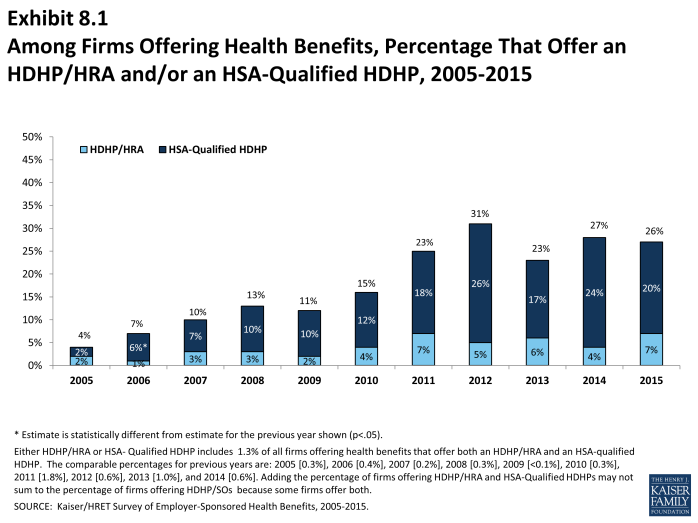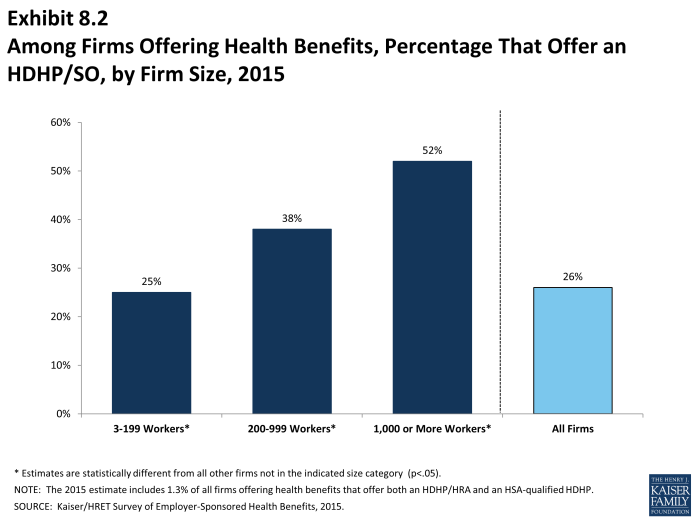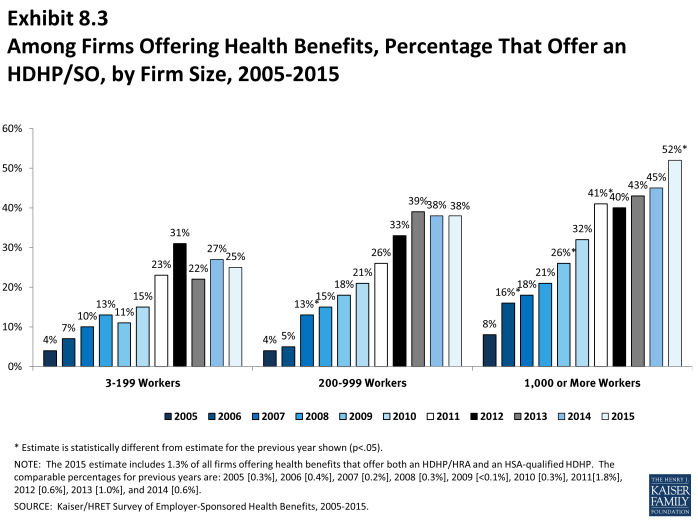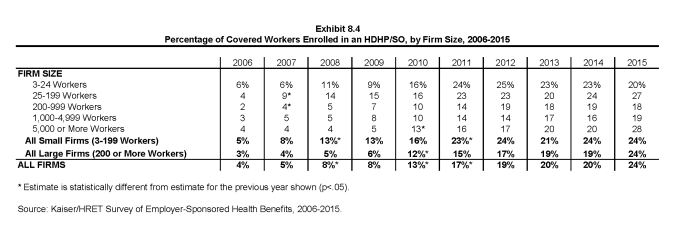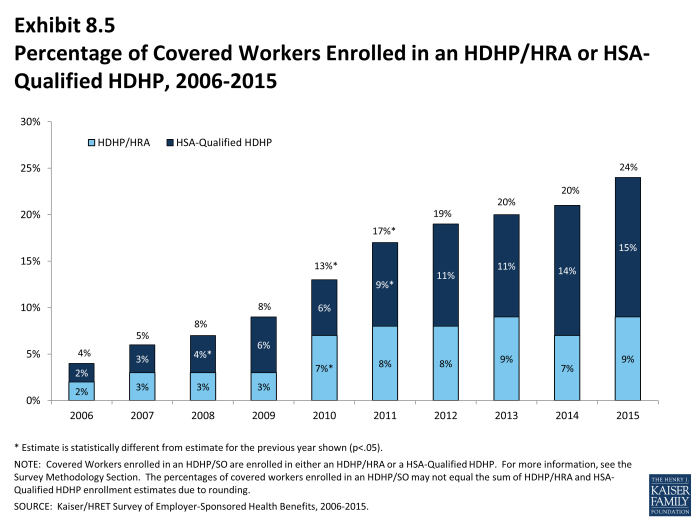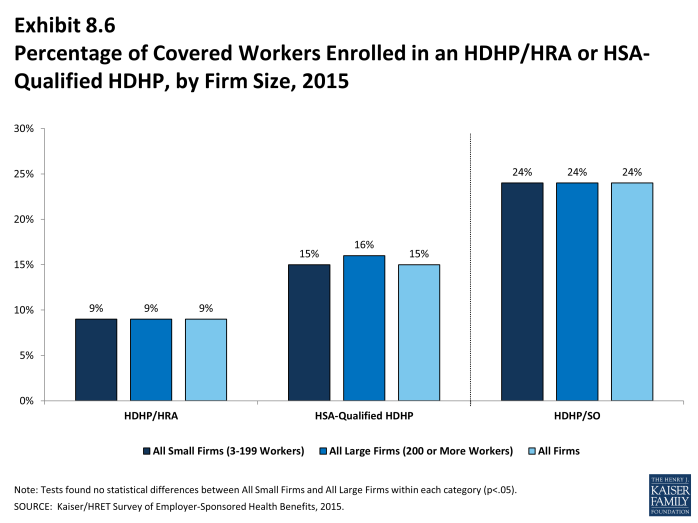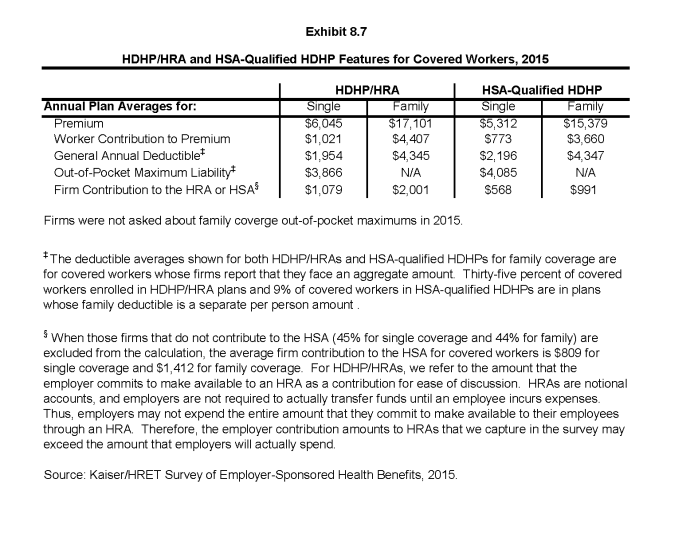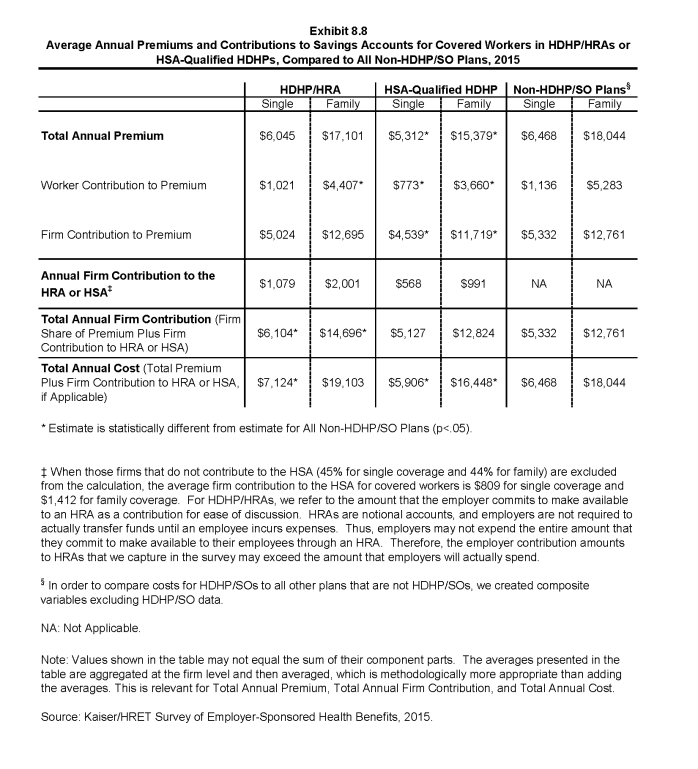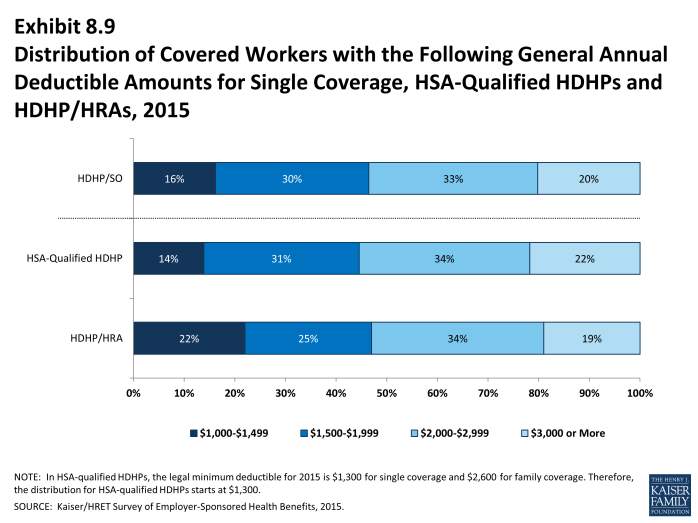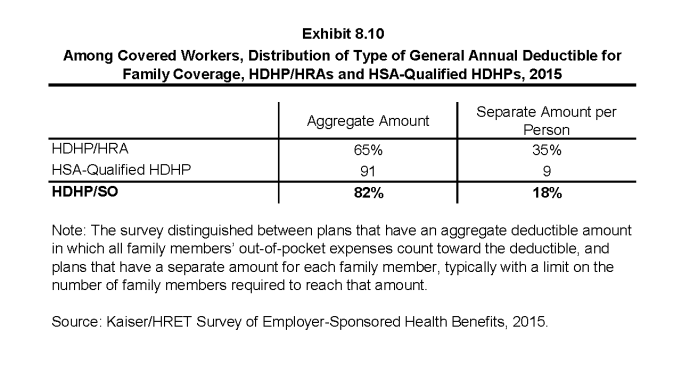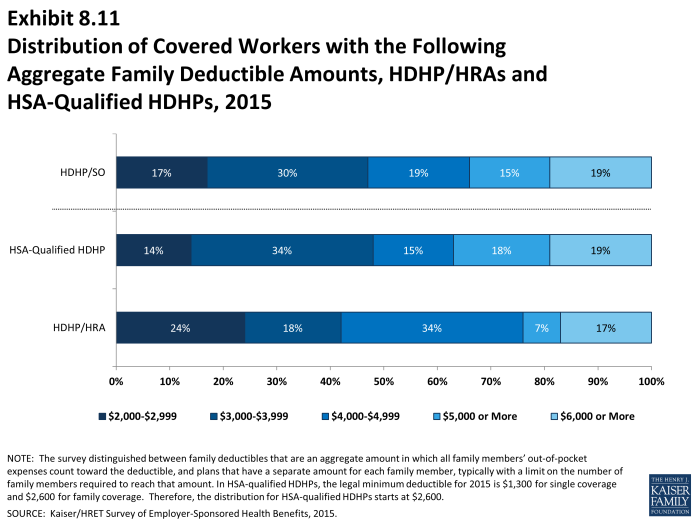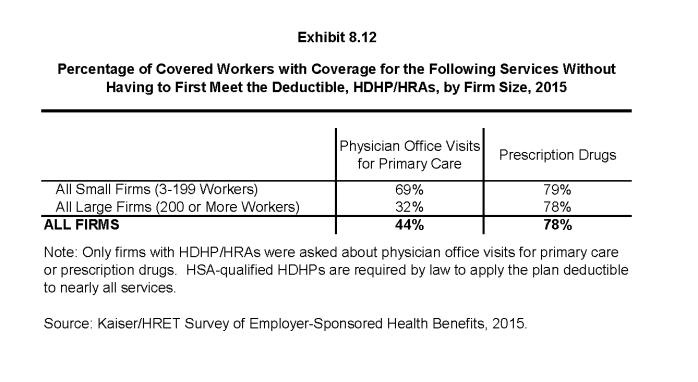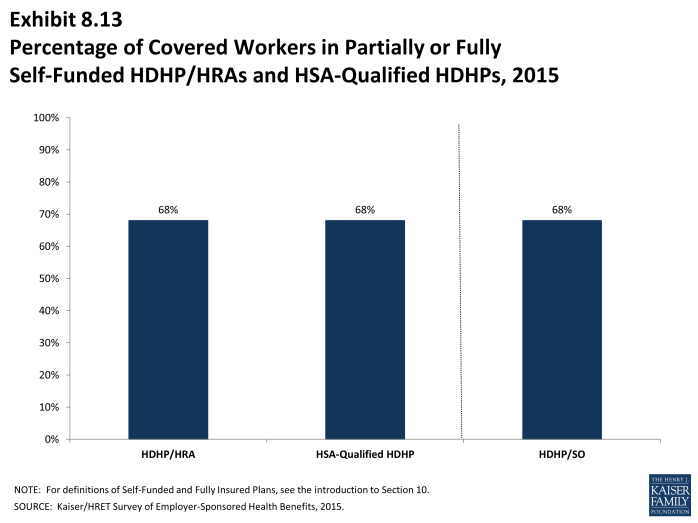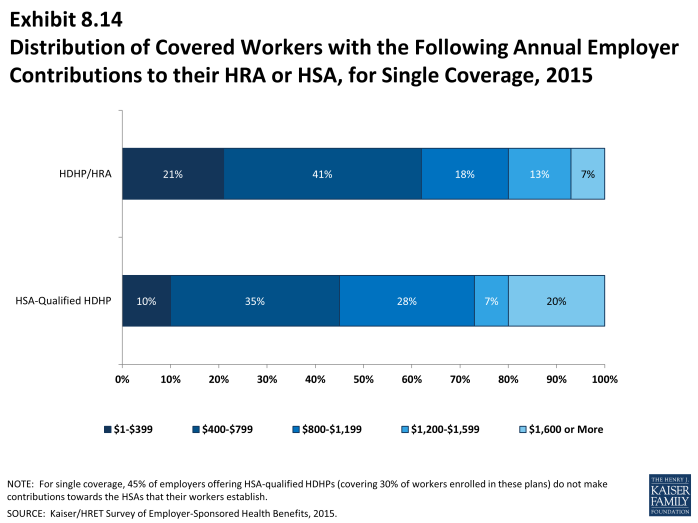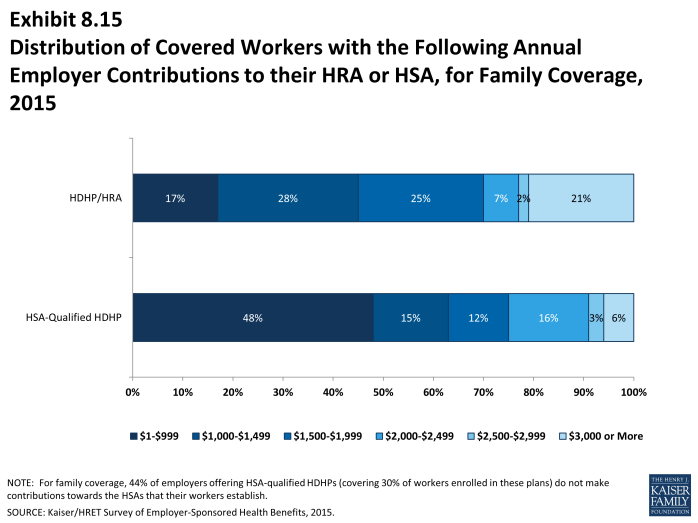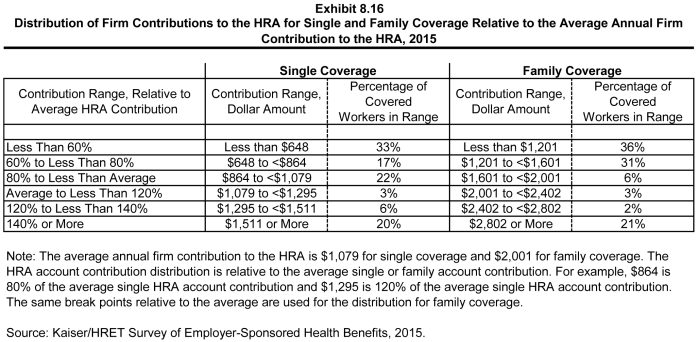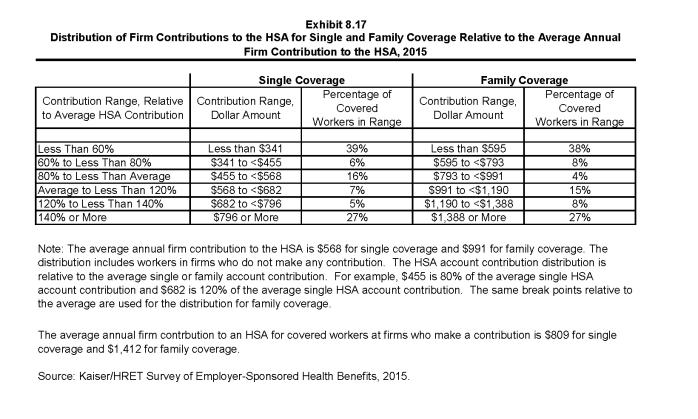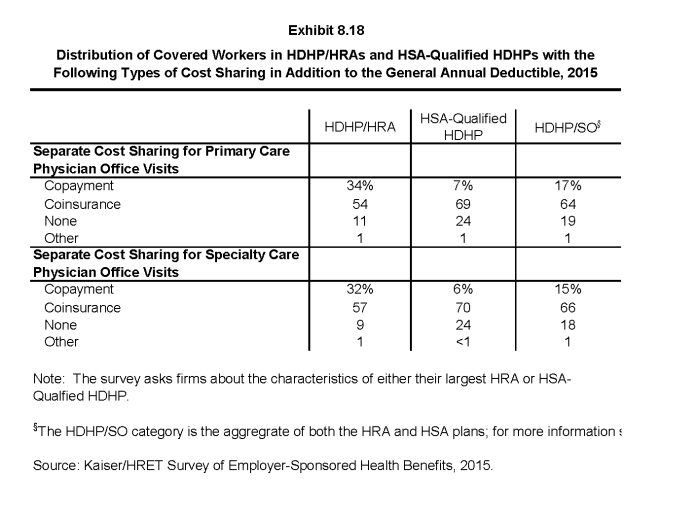2015 Employer Health Benefits Survey
Section Eight: High-Deductible Health Plans with Savings Option
To help cover out-of-pocket expenses not covered by a health plan, some employers offer high deductible plans that are paired with an account that allows enrollees to use tax-preferred savings to pay plan cost sharing and other out-of-pocket medical expenses. The two most common are health reimbursement arrangements (HRAs) and health savings accounts (HSAs). HRAs and HSAs are financial accounts that workers or their family members can use to pay for health care services. These savings arrangements are often (or, in the case of HSAs, always) paired with health plans with high deductibles. The survey treats high-deductible plans paired with a savings option as a distinct plan type – High-Deductible Health Plan with Savings Option (HDHP/SO) – even if the plan would otherwise be considered a PPO, HMO, POS plan, or conventional health plan. Specifically for the survey, HDHP/SOs are defined as (1) health plans with a deductible of at least $1,000 for single coverage and $2,000 for family coverage1 offered with an HRA (referred to as HDHP/HRAs); or (2) high-deductible health plans that meet the federal legal requirements to permit an enrollee to establish and contribute to an HSA (referred to as HSA-qualified HDHPs).2
Percentage of Firms Offering HDHP/HRAs and HSA-Qualified HDHPs, and Enrollment
- Twenty-six percent of firms offering health benefits offer either or both an HDHP/HRA or an HSA-qualified HDHP. Among firms offering health benefits, 7% offer an HDHP/HRA and 20% offer an HSA-qualified HDHP (Exhibit 8.1). The percentage of firms offering an HDHP/SO is similar to last year but has increased over time.
- Firms with 1,000 or more workers are significantly more likely to offer an HDHP/SO than smaller firms. Fifty-two percent of firms with 1,000 or more workers offer an HDHP/SO, compared to 25% of firms with 3 to 199 workers, and 38% of firms with 200-999 workers (Exhibit 8.2). Not all covered workers enrolled at a firm that offers an HDHP/SO may be eligible to enroll in the plan; for example, the HDHP/SO plan may only be offered in one location (see Section 4 for more information)
Health Reimbursement Arrangements (HRAs) are medical care reimbursement plans established by employers that can be used by employees to pay for health care. HRAs are funded solely by employers. Employers may commit to make a specified amount of money available in the HRA for premiums and medical expenses incurred by employees or their dependents. HRAs are accounting devices, and employers are not required to expend funds until an employee incurs expenses that would be covered by the HRA. Unspent funds in the HRA usually can be carried over to the next year (sometimes with a limit). Employees cannot take their HRA balances with them if they leave their job, although an employer can choose to make the remaining balance available to former employees to pay for health care.
HRAs often are offered along with a high-deductible health plan (HDHP). In such cases, the employee pays for health care first from his or her HRA and then out-of-pocket until the health plan deductible is met. Sometimes certain preventive services or other services such as prescription drugs are paid for by the plan before the employee meets the deductible.
Health Savings Accounts (HSAs) are savings accounts created by individuals to pay for health care. An individual may establish an HSA if he or she is covered by a “qualified health plan” –a plan with a high deductible (i.e., a deductible of at least $1,300 for single coverage and $2,600 for family coverage in 2015) that also meets other requirements.1 Employers can encourage their employees to create HSAs by offering an HDHP that meets the federal requirements. Employers in some cases also may assist their employees by identifying HSA options, facilitating applications, or negotiating favorable fees from HSA vendors.
Both employers and employees can contribute to an HSA, up to the statutory cap of $3,350 for single coverage and $6,650 for family coverage in 2015. Employee contributions to the HSA are made on a pre-income tax basis, and some employers arrange for their employees to fund their HSAs through payroll deductions. Employers are not required to contribute to HSAs established by their employees but if they elect to do so, their contributions are not taxable to the employee. Interest and other earnings on amounts in an HSA are not taxable. Withdrawals from the HSA by the account owner to pay for qualified health care expenses are not taxed. The savings account is owned by the individual who creates the account, so employees retain their HSA balances if they leave their job.
1 See U.S. Department of the Treasury, Health Savings Accounts, available at http://www.irs.gov/pub/irs-drop/rp-14-30.pdf
- In addition to looking at the percentage of firms that offer an HDHP/SO, the survey can analyze the percentage of workers who are enrolled in this plan type. Enrollment in HDHP/so plans has increased over time from 13% of covered workers in 2010 to 24% in 2015.
- Nine percent of covered workers are enrolled in HDHP/HRAs in 2015, and 15% percent of covered workers are enrolled in HSA-qualified HDHPs. Enrollment in both HSA-qualified HDHPs and HDHP/HRAs is similar to last year (Exhibit 8.5).
- A similar percentage of coverage workers at small firms (3-199 workers) and large firms are enrolled in HDHP/SOs (Exhibit 8.5).
Plan Deductibles
- As expected, workers enrolled in HDHP/SOs have higher deductibles than workers enrolled in HMOs, PPOs, or POS plans.
- The average general annual deductible for single coverage is $1,954 for HDHP/HRAs and $2,196 for HSA-qualified HDHPs (Exhibit 8.7). These averages are similar to the amounts reported in recent years. There is wide variation around these averages, however. Twenty percent of covered workers are enrolled in an HDHP/SO with a deductible of $3,000 or more (Exhibit 8.9).
- The survey asks employers whether the family deductible amount is (1) an aggregate amount (i.e., the out-of-pocket expenses of all family members are counted until the deductible is satisfied), or (2) a per-person amount that applies to each family member (typically with a limit on the number of family members that would be required to meet the deductible amount) (for more information see Section 7).
- The average aggregate deductibles for workers with family coverage are $4,345 for HDHP/HRAs and $4,347 for HSA-qualified HDHPs (Exhibit 8.7). As with single coverage, there is wide variation around these averages for family coverage. Nineteen percent of covered workers enrolled in HDHP/SO plans have an aggregate family deductible of $6,000 dollars or more (Exhibit 8.11).
Out-of-Pocket Maximum Amounts
- HSA-qualified HDHPs are legally required to have a maximum annual out-of-pocket liability of no more than $6,450 for single coverage and $12,900 for family coverage in 2015. Non-grandfathered HDHP/HRA plans starting in 2015 are required to have out-of-pocket maximums of no more than $6,600 for single coverage and $13,200 for family coverage. Ninety-nine percent of HDHP/HRA plans have an out of pocket maximum for single coverage.
- The average annual out-of-pocket maximum for single coverage is $3,866 for HDHP/HRAs3 and $4,085 for HSA-qualified HDHPs (Exhibit 8.7).
Premiums
- In 2015, the average annual premiums for HDHP/HRAs are $6,045 for single coverage and $17,101 for family coverage. The average single and family premiums for covered workers enrolled in HDHP/HRAs are similar to the average premiums for covered workers enrolled in non-HDHP/SO plans (Exhibit 8.8).
- The average annual premium for workers in HSA-qualified HDHPs is $5,312 for single coverage and $15,379 for family coverage. These amounts are significantly lower than the average single and family premium for workers in plans that are not HDHP/SOs (Exhibit 8.8).
- The average single and family coverage premiums for an HSA-qualified HDHPs are less than the premiums for covered workers enrolled in HDHP/HRAs (Exhibit 8.8).
Worker Contributions to Premiums
- The average annual worker contributions to premiums for workers enrolled in HDHP/HRAs are $1,021 for single coverage and $4,407 for family coverage (Exhibit 8.8).
- The average annual worker contributions to premiums for workers in HSA-qualified HDHPs are $773 for single coverage and $3,660 for family coverage. The average contribution for single coverage for workers in HSA-qualified HDHPs is significantly less than the average premium contribution made by covered workers in plans that are not HDHP/SOs (Exhibit 8.8).
Employer Contributions to Premiums and Savings Options
- Employers contribute to HDHP/SOs in two ways: through their contributions toward the premium for the health plan and through their contributions (if any, in the case of HSAs) to the savings account option (i.e., the HRAs or HSAs themselves).
- Looking at only the annual employer contributions to premiums, covered workers in HDHP/HRAs on average receive employer contributions of $5,024 for single coverage and $12,695 for family coverage (Exhibit 8.8).
- The average annual employer contributions to premiums for workers in HSA-qualified HDHPs are $4,539 for single coverage and $11,719 for family coverage. These amounts are lower than the average contributions for single or family coverage for workers in plans that are not HDHP/SOs (Exhibit 8.8).
- When looking at employer contributions to the savings option, workers enrolled in HDHP/HRAs on average receive an annual employer contribution to their HRA of $1,079 for single coverage and $2,001 for family coverage (Exhibit 8.8).
- HRAs are generally structured in such a way that employers may not actually spend the whole amount that they make available to their employees’ HRAs.4 Amounts committed to an employee’s HRA that are not used by the employee generally roll over and can be used in future years, but any balance may revert back to the employer if the employee leaves his or her job. Thus, the employer contribution amounts to HRAs that we capture in the survey may exceed the amount that employers will actually spend.
- Workers enrolled in HSA-qualified HDHPs on average receive an annual employer contribution to their HSA of $568 for single coverage and $991 for family coverage (Exhibit 8.8).
- In many cases, employers that sponsor HSA-qualified HDHP/SOs do not make contributions to HSAs established by their employees. Forty-five percent of employers offering single coverage and 44% offering family coverage through HSA-qualified HDHPs do not make contributions towards the HSAs that their workers establish. Thirty percent of workers with single coverage and thirty percent of workers with family coverage in an HSA-qualified HDHP do not receive an account contribution from their employer (see notes in (Exhibit 8.14) and (Exhibit 8.15)). Many employers are beginning to incorporate more complex structures to fund savings accounts, including providing a higher contribution if workers complete wellness or other health promotion activities.
- The percentage of covered workers enrolled in a plan where the employer makes no HSA contribution for single coverage (30%) is similar to the 24% last year and the percentage from five years ago.
- The average HSA contributions reported above include the portion of covered workers whose employer contribution to the HSA is zero. When those firms that do not contribute to the HSA are excluded from the calculation, the average employer contribution for covered workers is $809 for single coverage and $1,412 for family coverage (Exhibit 8.8).
- Employer contributions to savings account options (i.e., the HRAs and HSAs themselves) for their employees can be added to their health plan premium contributions to calculate total employer contributions toward HDHP/SOs.
- For HDHP/HRAs, the average annual total employer contribution for covered workers is $6,104 for single coverage and $14,696 for family coverage. The average total employer contribution amounts for single and family coverage in HDHP/HRAs are higher than the average amount that employers contribute towards single and family coverage in health plans that are not HDHP/SOs (Exhibit 8.8).
- For HSA-qualified HDHPs, the average annual total employer contribution for covered workers is $5,127 for single coverage and $12,824 for workers with family coverage. The total amounts contributed for workers in HSA-qualified HDHPs for single and family coverage are similar to the amounts contributed for workers not in HDHP/SOs (Exhibit 8.8).
Variation in Employer Contributions to Savings Options
- There is considerable variation in the amount that employers contribute to savings accounts.
- Thirty-three percent of covered workers are enrolled in a plan with an HRA annual contribution of less than $648 (less than 60% of the average) and 20% are enrolled in a plan with a contribution of $1,511 or more (at least 140% of the average) (Exhibit 8.16).
- Thirty-nine percent of covered workers are enrolled in a plan with an HSA annual contribution of less than $341 (less than 60% of the average) and 27% are enrolled in a plan with a contribution of $796 or more (at least 140% of the average) for single coverage (Exhibit 8.17).
Cost Sharing for Office Visits, Outpatient Surgery and Hospital Surgery
- The cost-sharing pattern for primary care office visits differs for workers enrolled in HDHP/SOs. Thirty-four percent of covered workers enrolled in HDHP/HRAs have a copayment for primary care physician office visits compared to 7% enrolled in an HSA-qualified HDHP (Exhibit 8.18). Workers in other plan types are much more likely to face copayments than coinsurance for physician office visits (see Section 7).

